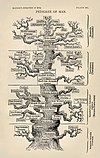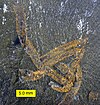User:Abyssal/Portal:Cambrian
IntroductionThe Cambrian ( /ˈkæmbri.ən, ˈkeɪm-/ KAM-bree-ən, KAYM-; sometimes symbolized Ꞓ) is the first geological period of the Paleozoic Era, and of the Phanerozoic Eon. The Cambrian lasted 53.4 million years from the end of the preceding Ediacaran period 538.8 million years ago (mya) to the beginning of the Ordovician period 485.4 mya. Its subdivisions, and its base, are somewhat in flux. The period was established as "Cambrian series" by Adam Sedgwick, who named it after Cambria, the Latin name for 'Cymru' (Wales), where Britain's Cambrian rocks are best exposed. Sedgwick identified the layer as part of his task, along with Roderick Murchison, to subdivide the large "Transition Series", although the two geologists disagreed for a while on the appropriate categorization. (Full article...) Selected natural world article
Sponges are animals of the phylum Porifera (/pɒˈrɪfərə/; meaning "pore bearer"). They are multicellular organisms that have bodies full of pores and channels allowing water to circulate through them, consisting of jelly-like mesohyl sandwiched between two thin layers of cells.
Sponges have unspecialized cells that can transform into other types and that often migrate between the main cell layers and the mesohyl in the process. Sponges do not have nervous, digestive or circulatory systems. Instead, most rely on maintaining a constant water flow through their bodies to obtain food and oxygen and to remove wastes. (see more...) Did you know...
Need help?Do you have a question about Abyssal/Portal:Cambrian that you can't find the answer to? Consider asking it at the Wikipedia reference desk. Selected image
Selected science, culture, and economics article In 1858, Charles Darwin and Alfred Russel Wallace published a new evolutionary theory that was explained in detail in Darwin's On the Origin of Species (1859). Unlike Lamarck, Darwin proposedcommon descent and a branching tree of life. The theory was based on the idea of natural selection, and it synthesized a broad range of evidence from animal husbandry, biogeography, geology, morphology, and embryology. The debate over Darwin's work led to the rapid acceptance of the general concept of evolution, but the specific mechanism he proposed, natural selection, was not widely accepted until it was revived by developments in biology that occurred during the 1920s through the 1940s. Before that time most biologists argued that other factors were responsible for evolution. The synthesis of natural selection with Mendelian genetics during the 1920s and 1930s founded the new discipline of population genetics. Throughout the 1930s and 1940s, population genetics became integrated with other biological fields, resulting in a widely applicable theory of evolution that encompassed much of biology—the modern evolutionary synthesis. (see more...) TopicsEpochs - Terreneuvian - Cambrian Series 2 - Cambrian Series 3 - Furongian Geography - Pannotia - Baltica - Gondwanaland - Laurentia - Siberia Fossil sites - Walcott Quarry Researchers - Stephen Jay Gould - Simon Conway Morris - Charles Doolittle Walcott SubcategoriesQuality ContentFeatured Cambrian articles - None Things you can doRelated contentAssociated WikimediaThe following Wikimedia Foundation sister projects provide more on this subject:
|





















